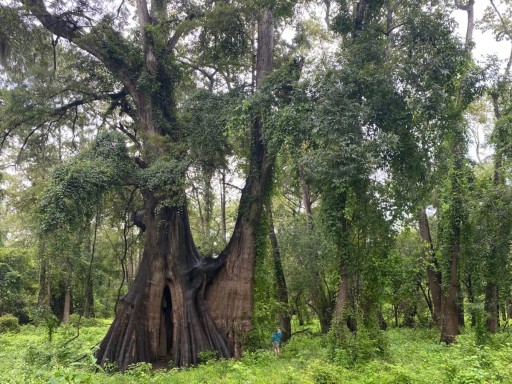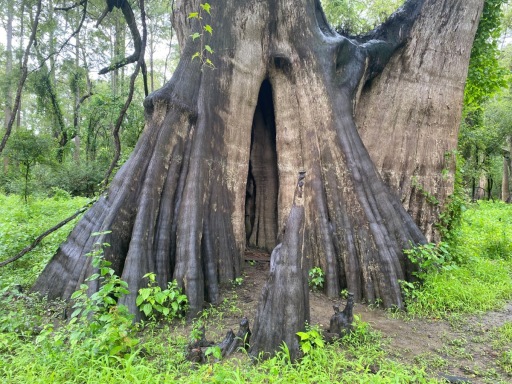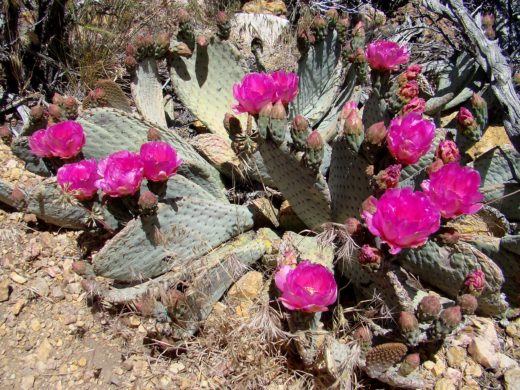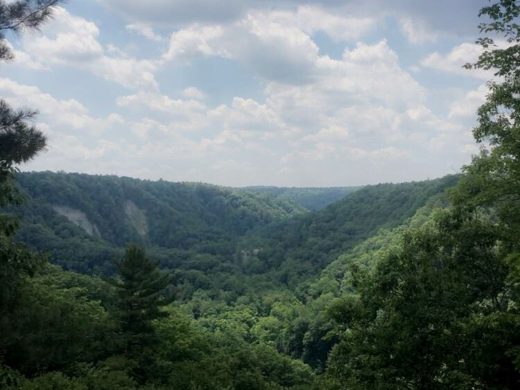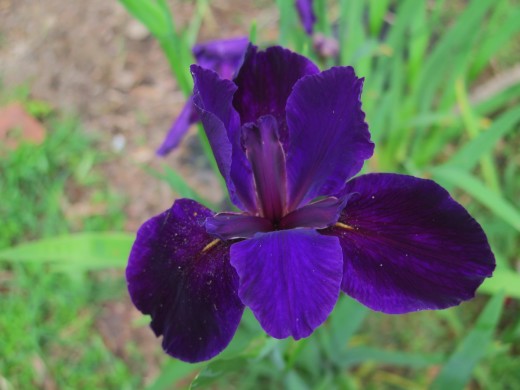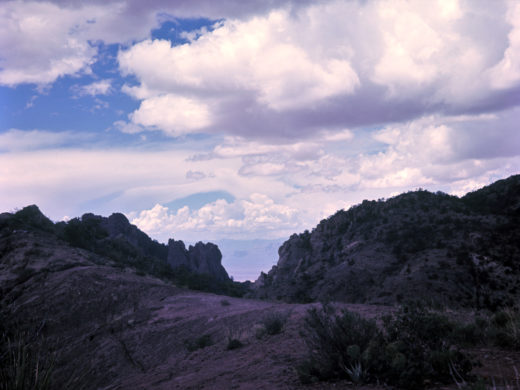Champion Bald Cypress at Cat Island Wildlife Refuge
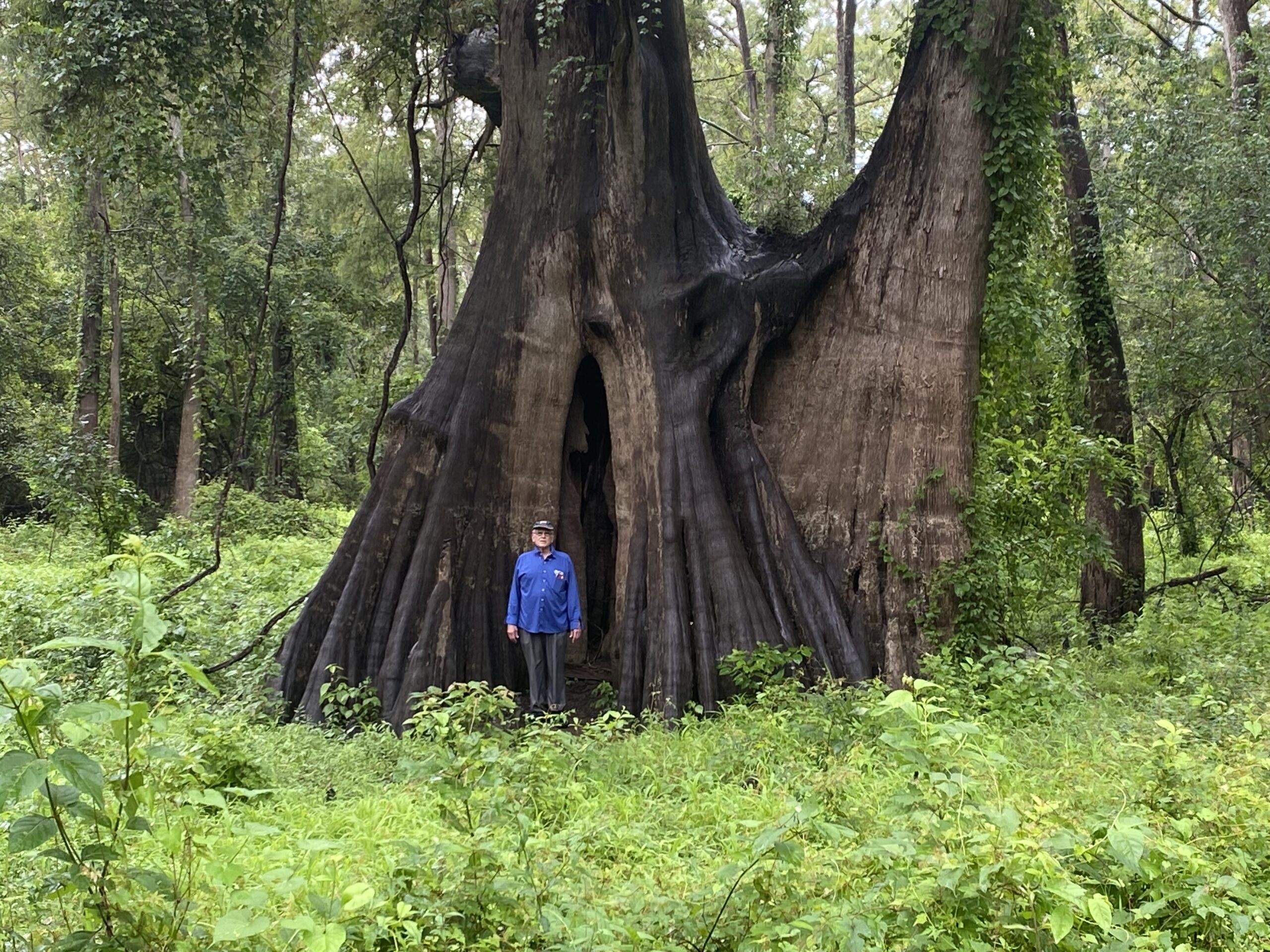
In August of 2022, we took a nature hike to Cat Island National Wildlife Refuge which is located along the ravines and swamps in several turns of the Mississippi River of Louisiana. It is about 30 miles north of Baton Rouge in West Feliciana Parish. Our goal was to visit a huge bald cypress tree which is located in the wildlife refuge. The tree is magnificent; it is estimated to be between 1,000 – 1,500 years old. The swamp was so quiet; with only the occasional sound of a singing or squawking bird — we were the only people around. With no noises from cars or machines, the tree stood there quietly in time. This reserve contains one of the last of the remaining ancient cypress groves. In addition to the trees, the wildlife refuge protects many species of birds and animals. We had attempted to visit the reserve about five years ago, but the road was washed out. Here are some photos from our most recent visit.
This is a special bald cypress. It is estimated to be between 1,000 – and 1,500 years old. It is the largest tree east of the Sierra Nevada range and the sixth largest tree in the United States. The tree is massive; we couldn’t see the top! Even the knobby roots are impressive. The tree is 96 feet in height, 17 feet in diameter and 56 feet in circumference.
This was our second visit to the wildlife reserve. We had made a trip about five years ago, but the dirt road, which goes along the banks of Bayou Sara, was washed out after massive rains, hurricanes and flooding. We wound up on private property and were promptly advised to turn around — in no uncertain terms. Since that adventure, the road has been re-build and directional signs have been erected. However, the route still is a dirt road and so we drove along at about ten miles-per-hour. There is no levee along the Mississippi River at this point, so when the water in the Mississippi rises above 20 – 24 feet, the refuge floods. It is it totally inaccessible to get to the reserve by auto or truck or foot. You have to cross this single lane, low water bridge to get to the entrance of the wild life refuge.
Cat Island Wildlife Refuge sign at the entrance to the reserve.
After driving for five or six miles on a dirt road, we came to a gravel parking A organization of folks who support this tree has constructed a sturdy path to the tree. It is about 1/2 mile in distance.
Looks can be deceptive and you don’t appreciate how large this tree is until you stand next to it. These knots/roots don’t seem that large.
However, the knobs were taller than myself — over five feet in height..
This is grand tree.
Looking up to the sky, it was impossible to see the top of the tree.
We did not see anyone else the entire day except for this Forest Service vehicle and person. We had the refuge to ourselves.
In addition to the prized bald, cypress tree, there are many other cypress trees growing in the swamp. These are younger ones as most of the ancient trees and forests were logged prior to this becoming an protected area.
Cypress trees depend on a cycle of flooding to reproduce. It is very important that the water level fluctuate. The purpose of the knotty cypress knees is unknown. They seem to be important in providing anchorage for the tree and enlarging and strengthening the basal root support. .
There are plenty of other wild life in the refuge. An American anhinga, water bird, put on quite a show for us. The birds perch on logs and flap their wings to dry off.
Here is the infant anhinga along with its mother.
Swampy water with a water bird who blends in perfectly — looking like a log. Look closely to see him.
We enjoyed our visit to Cat Island National Wildlife Refuge. Located in a bend of the Mississippi River, it is accessable by auto for only several months each year in the summer months, due to high water levels. After several previous attempts, we are lucky that we made is successfully to see the large bald cypress tree. It was quite an adventure.
Cat Island National Wildlife Refuge is managed as part of the Southeast Louisiana National Wildlife Refuges Complex. Nine Southeast Louisiana Refuges are part of a rich ecological system which includes marshes, pine and bottomland hardwood forests, lakes, barrier islands, swamps and bayous.The Cat Island National Wildlife Refuge was established in 2000 as the 526th National Wildlife Refuge System. This purpose of this refuge was to “to conserve, restore, and manage native forested wetland habitats for migratory birds, aquatic resources and endangered and threatened plants and animals.” I am glad that these nature resources are being preserved for future generations.
Reference:
https://www.fws.gov/refuge/cat-island#:~:text=The%20refuge%20is%20home%20to,and%2056%20feet%20in%20circumference.
https://www.fws.gov/refuge/cat-island/about-us
